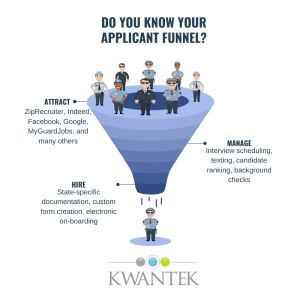LEADING AN ESSENTIAL WORKFORCE: TIPS FOR ACTIVELY MANAGING YOUR OFFICERS WHILE SUPPORTING THEM THROUGH CHALLENGING CIRCUMSTANCES
Anne L. Laguzza, M.A., The Works Consulting, CALSAGA Network Partner
While many are staying “safer at home,” your officers have been deemed essential and continue working to uphold the mission to protect property and environment. As a leader, you may be feeling the strain of operating beyond business as usual. Your officers may be feeling apprehensive about their normal posts.
In this challenging time, everyone is impacted both personally and professionally, even leaders. Everything is different. Actively managing your officers is critical to serving your clients but equally as important is supporting your officers as they perform their duties during these unprecedented circumstances.
Follow these five tips to actively manage your officers and support them well:
- Communicate Daily
Communication is a critical component of actively managing your officers. When uncertainty is prevalent, regular communication solves issues, often before they arise, and instills confidence in your workforce.
Using technology is key to staying in contact with your officers. Go beyond text messages and have a voice conversation. This extra step is critical to conveying empathy, understanding and taking a moment to value the officer, especially for officers who work solo without seeing anyone in management for weeks or months and can get disconnected quickly.
Your officers are likely to have questions. Have your officer’s duties changed at their post? Are there new health guidelines or safety protocols they must follow? Do they still report to the same person? If they worked with other officers before, will those shifts now be solo?
Communicate any changes in post directions, check in to see how they’re doing and inquire if they have any questions or need additional support.
- Convey Appreciation
Conveying your appreciation for these “essential” workers who continue to show up day after day while many people they know are staying “safer at home” is another critical component of actively managing your officers while also supporting them. You can do so much to make your officers feel valued and important with very little effort or cost.
When I worked internally in the industry, my job was to turn around morale and reduce employee complaints among the 600 employees. I was able to do both, just by recognizing the “human” in these officers and treating them with respect with every interaction. The president of our company was very good at getting out in the field and communicating with officers and shaking hands. These interactions made our employees feel valued and important.
Although you cannot shake hands with your officers right now due to social distancing, a phone call or other personalized communication to individual officers from the leader of your company to say thank you for continuing to serve during these unprecedented times will go a long way in ensuring your officers feel valued.
- Set Expectations While Understanding
Although the climate in which your officers are working in is unique, the best way to support them is to still set clear expectations while being understanding.
Your officers still need you to continue managing them, communicating expectations and keeping them accountable but with a general understanding that the unusual circumstances may result in your officers doing things that they have never done before because the situation warrants it.
Be open minded – look at the entire situation – and make decisions that are the best for the employee, the company and the client. Being flexible and expressing that you understand will make your officers feel supported when they need it most.
- Provide Additional Resources
Everyone processes circumstances differently. Providing additional resources, like an employee assistance program, is an impactful way to support your officers through challenging, extraordinary times.An Employee Assistance Program (EAP) is a voluntary, work-based program that offers free and confidential assessments for mental and emotional well-being, short-term counseling, referrals, and follow-up services to employees who have personal and/or work-related problems.
- Take Care of Yourself
As a leader, you may be so focused on supporting your teams through these challenging times that you might not realize that you are under a little more pressure than normal yourself.
It’s important for you as a leader to take actions that support your well-being. Debrief with fellow CALSAGA members. Connect with friends and family. Do something you enjoy in your free time. When you prioritize your well-being, you’ll be able to lead your teams well.
Taking time to actively manage your officers while thoughtfully supporting them during these challenging times will ensure that you and your officers serve your clients well now and come out stronger when this is all over.
Thank you for all you and your officers do for our communities!
Anne Laguzza is the President of The Works Consulting. As a seasoned business executive with human resources management, leadership development, and performance coaching experience, Anne works with clients from a variety of industries to develop better systems, maximize employee productivity, and enable management to focus on business growth.
Prior to founding The Works Consulting in 2001, Anne served as the Regional Human Resources Director for a Fortune 500 distribution company where she led a merger transition team and was responsible for strategic planning, implementing new policies and procedures, workforce restructuring, compensation structures, and integrating the work cultures for over 600 employees.
In addition, Anne was formerly the Human Resources and Training Director for a start-up entertainment company where she organized and implemented a company-wide change management program that involved new company direction and strategic planning. Prior to her work in the entertainment industry, Anne served as the Regional Training Manager for a nationwide retailer where she developed and launched a multi-state training program for human resources managers as part of a corporate expansion project.
Anne earned her Master of Arts degree in Organizational Management from Antioch University, and holds a Bachelor of Arts degree in Psychology from the University of California, Riverside. She is an active member of the Society of Human Resources Management, and is a board member for Harbor Interfaith Services and an advisory board member for Arthritis National Research Foundation. Anne has taught human resources and management courses at Long Beach City College and California State University, Dominguez Hills, and volunteers at non-profit organizations teaching interviewing skills to adults seeking re-entry into the workforce.

 Mark was named to the prestigious IFSEC Global influencers list in 2018 & 2019 for “Security Thought Leadership”. He is also a highly active international security figure, member of ASIS and a Fellow of the UK Security Institute, as well as a world renown data-driven Operations & Security leadership expert. Mark is based in Montreal, Canada with TrackTiK, a dynamic and cutting edge tech company. Mark is also a lecturer and commentator on global security issues.
Mark was named to the prestigious IFSEC Global influencers list in 2018 & 2019 for “Security Thought Leadership”. He is also a highly active international security figure, member of ASIS and a Fellow of the UK Security Institute, as well as a world renown data-driven Operations & Security leadership expert. Mark is based in Montreal, Canada with TrackTiK, a dynamic and cutting edge tech company. Mark is also a lecturer and commentator on global security issues. As we enter a new decade, it’s fun to reflect on how hiring has changed over the past 10 years.
As we enter a new decade, it’s fun to reflect on how hiring has changed over the past 10 years.
 Shaun Kelly joined Tolman & Wiker Insurance Services in 2005. He specializes in all lines of property and casualty insurance for industries including contract security firms, agriculture, construction, oil and gas. Shaun received a BS in Business Administration with a major in Finance from California State University in Fresno, California. He is an active member of several industry associations, including the Association CALSAGA, the Kern County Builders Exchange and the Independent Insurance Agents of Kern County. Shaun can be reached at 661-616-4700 or skelly@tolmanandwiker.com.
Shaun Kelly joined Tolman & Wiker Insurance Services in 2005. He specializes in all lines of property and casualty insurance for industries including contract security firms, agriculture, construction, oil and gas. Shaun received a BS in Business Administration with a major in Finance from California State University in Fresno, California. He is an active member of several industry associations, including the Association CALSAGA, the Kern County Builders Exchange and the Independent Insurance Agents of Kern County. Shaun can be reached at 661-616-4700 or skelly@tolmanandwiker.com.